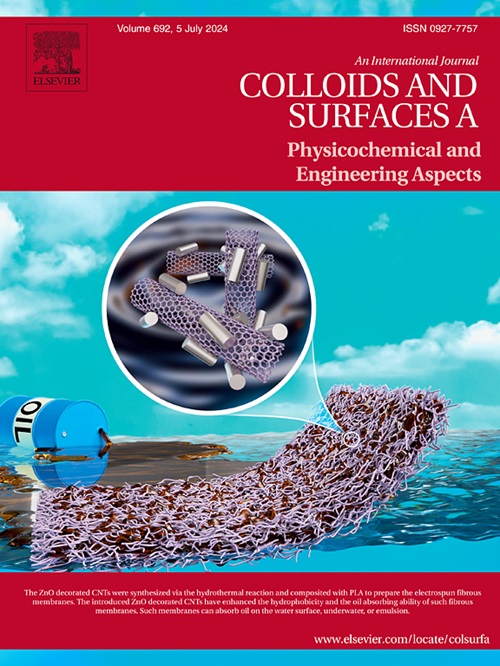基于多壁碳纳米管修饰的玻璃碳电极锚定钒酸锌的电化学传感器的制作,用于测定多菌灵
IF 4.9
2区 化学
Q2 CHEMISTRY, PHYSICAL
Colloids and Surfaces A: Physicochemical and Engineering Aspects
Pub Date : 2024-11-12
DOI:10.1016/j.colsurfa.2024.135754
引用次数: 0
摘要
多菌灵(CBZ)杀虫剂的检测引发了人们对其对人类健康和环境潜在影响的担忧。为解决这一问题,我们采用普通水热技术制备了一种新型纳米复合材料,其中包括钒酸锌(ZVO),并将其与多壁碳纳米管(MWCNT)结合形成 ZVO/MWCNT 纳米复合材料。因此,使用这种 ZVO/MWCNT 纳米复合材料对玻璃碳电极(GCE)进行了改性,为 CBZ 的电化学检测提供了一个简单、经济的平台。通过各种显微镜和光谱技术确认了纳米材料的结构和组成,并使用电化学阻抗谱(EIS)、差分脉冲伏安法(DPV)和循环伏安法(CV)技术研究了其电化学特性。经 GCE/ZVO/MWCNT 修饰的电极具有 0.05 至 110 μM 的宽线性响应,检出限低至 0.005 μM,灵敏度高(2.93 μA μM-1 cm-2),回收率为 98 % 至 99.93 %。此外,GCE/ZVO/MWCNT 电极在检测 CBZ 方面表现出卓越的稳定性、可重复性和实用性。电化学研究表明,氧化产物的形成与双电子转移过程一致。因此,这种创新的 GCE/ZVO/MWCNT 修饰电极为灵敏、选择性地测定 CBZ 提供了广阔的前景,有望应用于环境监测和健康保护领域。本文章由计算机程序翻译,如有差异,请以英文原文为准。
Fabrication of an electrochemical sensor based on Zinc Vanadate anchored with multi-walled carbon nanotubes modified glassy carbon electrode for the determination of Carbendazim
The detection of Carbendazim (CBZ) insecticides has prompted concerns regarding their potential impacts on both human health and the environment. To address this issue, a novel nanocomposite comprising Zinc Vanadate (ZVO) was prepared using a common hydrothermal technique and incorporated with multi-walled carbon nanotube (MWCNT) to form ZVO/MWCNT nanocomposite. Thus, a glassy carbon electrode (GCE) has been modified using this ZVO/MWCNT nanocomposite, which offering a simple and affordable platform for the electrochemical detection of CBZ. The structure and composition of the nanomaterial were confirmed through various microscopic and spectroscopic techniques, while its electrochemical characteristics were investigated using electrochemical impedance spectroscopy (EIS), differential pulse voltammetry (DPV), and cyclic voltammetry (CV) techniques. The GCE/ZVO/MWCNT modified electrode exhibited a broad linear response ranging from 0.05 to 110 μM, with a low detection limit of 0.005 μM and high sensitivity (2.93 μA μM−1 cm−2), with recoveries ranging from 98 % to 99.93 %, respectively. Moreover, GCE/ZVO/MWCNT electrode demonstrated excellent stability, repeatability, and practical utility for CBZ detection. Based on electrochemical studies that indicate the formation of oxidized products consistent with a 2-electron transfer process. Therefore, this innovative GCE/ZVO/MWCNT modified electrode offers promising prospects for sensitive and selective CBZ determination, with potential applications in environmental monitoring and health protection.
求助全文
通过发布文献求助,成功后即可免费获取论文全文。
去求助
来源期刊
CiteScore
8.70
自引率
9.60%
发文量
2421
审稿时长
56 days
期刊介绍:
Colloids and Surfaces A: Physicochemical and Engineering Aspects is an international journal devoted to the science underlying applications of colloids and interfacial phenomena.
The journal aims at publishing high quality research papers featuring new materials or new insights into the role of colloid and interface science in (for example) food, energy, minerals processing, pharmaceuticals or the environment.

 求助内容:
求助内容: 应助结果提醒方式:
应助结果提醒方式:


